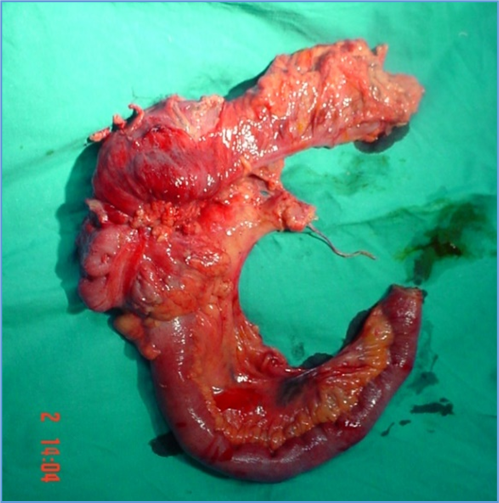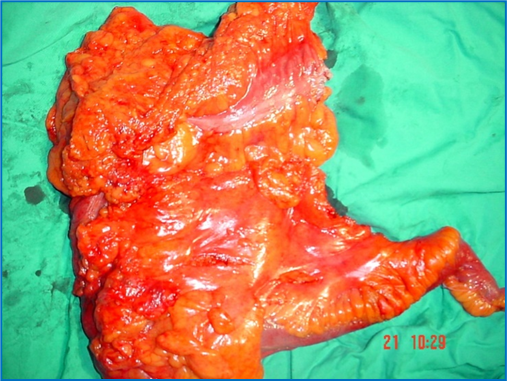AUCTORES
Globalize your Research
Review Article | DOI: https://doi.org/10.31579/2690-4861/766
1 Clinic for Digestive Surgery, University Clinical Center Nis, 18000 Nis, Serbia.
2 Internal Medicine Clinic, University Clinical Center Nis, 18000 Nis, Serbia.
*Corresponding Author: Ilija Golubovic, Clinic for Digestive Surgery, University Clinical Center Nis, 18000 Nis, bul. dr Zorana Djindjica 48, 18000 Nis, Republic of Serbia.
Citation: Ilija Golubović, Goran Stanojević, Aleksandar Vukadinovic, Marko Stojanovic, (2025), Complete Mesocolic Excision for the Treatment of Right-Sided Colon Cancer: Anatomical Consideration, Surgical Technique and Outcomes, International Journal of Clinical Case Reports and Reviews, 25(3); DOI:10.31579/2690-4861/766
Copyright: © 2025, Ilija Golubovic. This is an open-access article distributed under the terms of the Creative Commons Attribution License, which permits unrestricted use, distribution, and reproduction in any medium, provided the original author and source are credited.
Received: 31 March 2025 | Accepted: 08 April 2025 | Published: 17 April 2025
Keywords: complete mesocolic excision (CME); right-sided colon cancer; anatomy; surgical technique; outcomes
Since total mesorectal excision (TME) reduces local recurrence rates, it is considered the gold standard surgical procedure for treating locally advanced rectal cancer. These discoveries led to the use of the dissection principle in colon cancer surgery using complete mesocolic excision (CME) and central vascular ligation (CVL). A successful CME operation encompasses three critical components: the specimen must be removed in the mesocolic plane, the supplying blood vessels should be ligated at their origin, and an adequate length of the colon must be removed. Education and comprehensive knowledge of vessel anatomy are essential; otherwise, there is a risk of increased morbidity. CME implementation began with the aim of developing a new concept for colon cancer surgery that would improve patient outcomes. This operation yields high-quality specimens that may suggest better long-term oncologic outcomes, although the morbidity associated with CME is typically higher than that of standard right hemicolectomy. To date, published series on CME are predominantly retrospective and heterogeneous. As a consequence, the analysis of oncological findings should be approached with caution. Evidence regarding the quality is insufficient and does not consistently demonstrate the superiority of CME.
Colorectal cancer (CRC), also known as colorectal adenocarcinoma, is increasingly widespread in developing countries and is currently the third particularly high cause of cancer mortality globally, accounting for 11% of all cancer diagnoses. Cancer of the colon is the fourth most incident, while cancer of the rectum is the eighth most incident cancer in the world [1]. GLOBOCAN 2018 estimates around 1,096,000 new cases of colon cancer detected in 2018 [2].
Using a new approach to rectal cancer using total mesorectal excision (TME) techniques, first described in 1979 by Professor Richard J. Heald, has led to changes in the rectal cancer surgery also affected outcomes [3]. Thus, with the application of TME, a higher probability for clean circumferential margin is achieved [4], with a marked decrease in local recurrence rates from 30%-40% to 5%-15%, and on the other hand, the rate of survival after five years has risen from 45%-50% to 75% [5, 6].
The surgical principles of TME, Hohenberger et al. applied for the surgery of colon cancer through complete mesocolic excision (CME) and central ligation [7, 8]. This approach focuses on the a separation of the mesocolic from the parietal plane and the central vascular ligation (CVL) of the supplying arteries and draining veins, performed as near as feasible to their junction with the mesenteric vasculature. CME has also been shown to improve survival and local recurrence rates as compared to conventional colon cancer surgery, according to several authors. The majority of these studies are retrospective cohort a series arrangement, and several lack a comparison group [9-13]. However, CME concepts have not been widely accepted [14], and colon cancer survival rates have now declined behind those of rectal cancer [15].
Furthermore, it is also important to emphasize that previously published studies demonstrated a correlation between gender and age, revealing a higher incidence of right-sided colon cancers (RSCCs) in women and older individuals [16, 17]. Patients with right-sided and left-sided colon cancer (LSCC) exhibit variations in epidemiology, perioperative evolution, histology, survival rates [18, 19], and molecular biology pathways [20].
Consequently, it has been proposed to regard CRC as three different tumor entities: RSCC, LSCC, and rectal cancer. Right-sided cancers are typically characterized as malignancies occurring proximal to the splenic flexure, whereas left-sided cancers are situated distal to the splenic flexure. A large corpus of literature exists [8-13] that recognises the importance of complete mesocolic excision for colon cancer and which ask the question: Is this the appropriate moment for a transformation in practice? We aim to describe anatomical background as well as The approach and outcomes of the CME technique for the treatment of RSCC.
Anatomical consideration
Sir Frederick Treves' observations in 1885 led to the classical anatomical classification of the mesocolon. Treves researched the anatomy of the human intestinal canal, peritoneum, and mesentery. He reported a case collection of 100 cadaveric surgical dissections to the Royal College of Surgeons in England, observing that roughly fifty percent of the cadavers examined lacked an ascending or descending mesocolon. Carl Toldt notably recognized the persistence of the mesocolon into adulthood in 1879, some years before to Treves. In 1879, he published his study of the anatomy and development of the human mesentery. Toldt also identified a specific fascial plane between the mesocolon and the underlying retroperitoneum, formed by the fusion of the mesocolon's visceral peritoneum with the retroperitoneum's parietal peritoneum (Toldt's fascia) [21, 22].
In order to explain CME, it is important to consider the anatomical properties of the mesocolon. Regarding the anatomical background of CME it is important to point out that CME involves tissue mobilization through the release of planes during dissection between the parietal and mesenteric fasciae. This avascular space is formed during the secondary attachment of the parietal and visceral fascia and it can be divided by surgery through sharp dissection [23]. Furthermore, it is important to distinguish the following terms [5, 24] defined in Table 1.
| Terms | Definition |
| Toldt’s Fascia | An extra fascial plane between the mesocolon and retroperitoneum |
| Colo-fascial interface | Confluence of colonic surface and Toldt’s Fascia |
| Meso-fascial interface | Confluence of mesocolon and Toldt’s Fascia |
| Retro-fascial interface | Confluence of retroperitoneum and Toldt’s Fascia |
Table 1: Definition of anatomical terms for better understanding of CME
To carry out CME for right colon malignancies within the appropriate anatomical planes, vascular anatomy should be thoroughly studied beforehand. The SMA contains two or three principal branches that give arterial blood to the right colon. In many cases, the right colic artery (RCA) is not an anatomical constant. The ascending colon is usually supplied by the right branch of the middle colic artery (MCA). An accessory MCA exists in 11.7%. In 100% of cases, the ileocolic artery (ICA) and MCAs are constant vessels arising from the SMA[25, 26]. The most significant of these branches is the ICA. The ICA may encircle the superior mesenteric vein (SMV) or lie underneath the ileocolic vein (ICV). This is a large difference that must be taken into account during the central vessel ligation procedure [23, 7].
To prevent vascular complications during CME, it is important be familiar with the venous architecture of the right colon and its variations. The venous blood from the cecum, ascending colon, and the right portion of the transverse colon drains into the SMV. However, there are various differences in the topographical anatomy of the right colic vein (RCV), superior RCV, gastrocolic trunk, and middle colic vein (MCV) [27, 28]. The RCV, the gastroepiploic vein, and the pancreatic veins do not routinely drain into the SMV separately. Their drainage is most generally provided by a common vein, the trunk of Henle, which is found in approximately 88 percent of all cases [26, 29]. The research conducted by Miyazawa et al. (2015) [30] revealed variations of the colic drainage veins entering the gastrocolic trunk of Henle, as identified using three-dimensional multidetector computed tomography: Type 0 is represented with right gastroepiploic vein (RGEV), and anterior superior pancreaticoduodenal vein (ASPDV); Type I is represented with RGEV + ASPDV + superior right colic vein (SRCV); Type II is represented with RGEV + ASPDV + SRCV + RCV or MCV; and Type III is represented with RGEV + ASPDV + SRCV + RCV + MCV. The drainage of these veins through the trunk of Henle or directly in the SMV underpins a difference that surgeons must consider when mobilizing the hepatic flexure of the colon. When attempting proper central vascular ligation, surgeons need to have a comprehensive understanding of the vasculature and any variations that may exist. Whit correct central vessel ligation, the extraction of the core portion of the tumor-draining lymph nodes is facilitated. This is important because it will affect the prognosis of the patients [7].
Surgical technique of CME
In our paper, only open and laparoscopic surgery in relation to CME will be presented, considering that robotic-assisted CME is a promising and safe minimally invasive procedure, as indicated by recent studies [31, 32].
Open surgery
A “lateral-to-medial” approach is generally performed in open surgery. In RSCCs, recognizing the avascular space between the parietal and mesenteric fasciae is crucial for dissection [33-35]. Toldt’s fascia defined as a single fascial layer separates mesocolon from retroperitoneum. Deviation from this dissection can lead to bleeding and even to damage of retroperitoneal structures. The dissection proceeds medially within the mesofascial interface. The dissection is thereafter conducted over the duodenum and pancreatic uncinate process to facilitate access to the superior mesenteric vein and artery [36]. At this point in time duodenal kocherization is not typically conducted [8]. Thus applying the dissection pathway medially the small intestinal mesentery, ileocecal junction, right colon, right mesocolon and mesenteric confluence are fully mobilized. It is important to emphasize that care must be taken to identify and preserve the autonomic nervous plexus [36].
The anatomy and its variations can be precisely identified by incising the peritoneum surrounding the vessels. Additionally, the central ligation of the ileocolic and right colic vessels—when present, as the RCA occurs in fewer than fifty percent of cases—at their origin from the superior mesenteric vessels ensures the retrieval of all lymph nodes draining the tumor.
The dissection is then performed centrally along the SMA, enabling removal of all associated lymph nodes [36]. The right branch of the middle colic vessels is divided [8, 36, 38] for cecal and ascending colon cancers after it is entered the lesser sac. Access to the lesser sac is achieved by transecting the right gastroepiploic artery for neoplasms found in the hepatic flexure or proximal transverse colon. To access the peripancreatic lymph nodes it is necessary mainly to divide the right gastro-epiploic artery at its origin [8, 36]. Lymph nodes located at the inferior border of the left pancreas and those along the left gastroepiploic arcade may be excised for colon tumors positioned to the left of the MCA [39].
Additionally, the MCV is divided at its junction with either the SMV or the gastrocolic trunk (trunk of Henle), whereas the MCA is divided at its origin from the SMA [8, 34, 36, 38]. At the level of the middle colic vessels [8], the colon is divided. For hepatic flexure cancers, the colon is divided near to the splenic flexure [8]. It is important to keep in mind that the veins draining into the gastrocolic trunk show a variability. The tiny veins around the trunk of Henle may rupture, resulting in significant hemorrhage; thus, caution is essential during dissection (Table 1). Given that during right-sided CME usually only the RCV needs to be cut, it is important to approach it carefully to the RCV, the RGEV, and the anterior pancreatic veins that can drain to the trunk of Henle or communicate separately to the SMV.
Laparoscopic surgery
CME can be performed laparoscopically with comparable quality to open operations [40]. A “medial-to-lateral” approach is preferable. In very unusual circumstances, a lateral-to-medial approach can be used. In right hemicolectomy, the mesocolon is incised along the mesenteric axis next to the SMV. Further, right colon vessels (ICV, ileocecal vein; ICA, ileocecal artery; RCV; RCA) are ligated at their origin. The gastrocolic trunk of Henle is then exposed by dissection along the superior mesenteric vein[40].
The MCA is recognized as arising from the SMA and diverging near the base of its right branch. Lymph node dissection is thereafter performed, preserving the left branch of the main colic artery. Simultaneously, the MCV is identified and transected near the origin of its right branch. In cases with cecum or ascending colon malignancies, the right branch of the middle colic vessels is ligated at its root, and the transverse colon is transected at the level of the middle colic vessels. In cases of proximal transverse colon or hepatic flexure malignancies, the middle colic and right gastroepiploic vessels are ligated at their root [7, 35].
After that, the right side of the greater omentum is dissected using anterior-to-median approach. Between the omentum and the transverse mesocolon, the fusion fascia is detached, and the hepatic flexure is mobilized [41]. The accessory MCVs are meticulously dissected, and lymph nodes are dissected as well. The transverse mesocolon is dissected beneath the inferior margin of the pancreas, revealing the SMV. The specimen is obtained by a mini-laparotomy, and the anastomotic approach (intracorporeal or extracorporeal) is contingent upon the surgeon's expertise and preference [7, 11, 40, 41].
The use of laparoscopic surgery to treat colon cancer near the flexures and in the transverse colon is also debatable. The open approach is the preferred procedure for these tumors in many hospitals [42].
Outcomes of CME in the literature
Two models have been suggested in the past to describe epithelial cancer nodal distribution. In Halsted's initial stepwise model, nodal metastasis occurs both temporally and spatially prior to distant dissemination. If this scenario is true, eliminating as many (possibly) invaded nodes as possible can avoid further tumor spread and result in a survival advantage. Fisher's parallel distribution model assumes that distant metastasis occurs very early in the disease. This model regards lymph node metastasis as a marker of the disease's biological activity and malignancy, asserting that the excision of infected nodes does not influence survival outcomes [43-45].
Willaert et al. (2015) demonstrated that factors such as circulating tumor cells in peripheral blood, growth rates of primary colon cancer and liver metastases, early dissemination, and information regarding the quantity and location of invaded lymph nodes and their prognostic implications indicate that the lymphatic spread of colon cancer is an unpredictable event rather than a phased one, potentially occurring early in tumor progression. Surgical attempts at optimal nodal clearance are unlikely to influence the probability of systemic dissemination. Consequently, the future of surgical oncology is oriented towards more precise, imaging-guided, less invasive, and less traumatic surgical techniques, integrated within the context of multiple modalities guided by the latest advancements in cancer biology [45].
Furthermore, colon cancer surgical resection was graded by the colonic grading system as being in the muscularis propria plane (“poor” plane of surgery), intramesocolic plane (“moderate” plane of surgery), or mesocolic plane (“good” plane of surgery) (Figure 1 and 2). A fourth category was subsequently built up when surgery is performed in the mesocolic plane with a high vascular tie near to the aorta. This method of intensive surgery is designed to remove the entire colonic mesentery, including all possible nodal and intravascular tumor spread sites [46].

Figure 1: Pathology grading of colon cancer surgical resection: Intramesocolic plane (“moderate” plane of surgery—moderate bulk to mesocolon with irregularity but the incisions do not reach down to the muscularis propria)

Figure 2: Pathology grading of colon cancer surgical resection: Mesocolic plane (“good” plane of surgery— intact mesocolon with a smooth peritoneal-lined surface)
Given all of these variables and the lack of data from prospective randomized studies with relevant clinical outcomes, CME should be regarded as investigational; therefore in our study three types of outcomes were of interest: The safety of CME, the quality of CME as well as oncological outcomes.
There is a large volume of published studies comparing CME and non-CME. It was found CME demonstrated superior survival rates despite being linked to an a higher rate of complications [47, 48]. Recent research indicates that laparoscopic CME with D3 lymph node dissection is a safe and feasible surgical alternative for right colon cancer in older individuals [49]. In an analysis of anastomotic leak, Prevost et al. (2018) found no significant difference in the rate of anastomotic leak (1.2% in the conventional versus 5.6% in the CME/CVL group). The study indicated a propensity for delayed gastric emptying in the CME/CVL group [50]. It has been demonstrated that application of CME results in reduction of locoregional recurrence from 6.7% to 2.1% for all stages; distant organ metastatic rate decreased from 18.9% to 13.3% [51]. Furthermore, CME was associated with a longer colonic resection, and more lymph nodes [9, 52, 53].
However, all of these series encompass results for both right and left colon cancer. Several recent studies have compared CME and non-CME outcomes for RSC.
According to a research by Bertelsen and colleagues [54] the 5-year results for patients with potentially curable stage I–III colon cancer show a significant reduction in recurrence to 9,7% in the CME group compared to 17,9% in the non-CME group. In a study which set out to determine the safety of CME, Bertelsen (2018) observed that complete mesocolic excision did not correlate with an elevated risk of diarrhea or diminished quality of life (55).
Furthermore, the study by Rasulov et al. (2017) demonstrated that there was no postoperative mortality following complete mesocolic excision for right colon cancer, with 17 procedures conducted via open technique and 22 via laparoscopic method. The study reported a median
intraoperative blood loss of 30 ml (range 30-300 ml) for the laparoscopic technique and 300 ml (range 30-500 ml) for the open approach. The median number of excised lymph nodes was 35.7 (range 6-68), whereas the median number of metastatic lymph nodes was 1.9 (range 0-16) [56].
Vajda et al. (2020) [57] examined a cohort of 156 consecutive patients who underwent surgery for malignant RSCC between September 1, 2016, and June 30, 2019. There were 84 laparoscopic procedures and 59 open surgeries conducted. The mean specimen length was 22.34 cm for conventional surgery and 24.97 cm for CME surgery, whereas the average number of lymph nodes was 15.4 and 16.9, respectively (p = 0.24). Preliminary data suggest that the procedure may be conducted laparoscopically, yielding outcomes comparable to open surgery, but with a reduced period of hospital stay [57].
Similar results in their study are presented by Zedan et al. (2021) comparing laparoscopic versus open complete mesocolic excision for right colon cancer [58]. The authors determined that with experienced surgeons, laparoscopic CME right hemicolectomy is a feasible and safe treatment, with long-term oncologic outcomes (recurrence and survival) comparable to open surgery for patients with stage II or III colon cancer. Additionally, the study by Huang et al. (2015) retrospectively assessed the clinical data of 102 patients who underwent right colon resection. The operative time in the laparoscopic surgery (LS) group was similar to that in the open surgery (OS) group, while intraoperative blood loss fell significantly in the LS group when compared to the OS group. In their study, there was no difference in the total number of harvested lymph nodes between the groups and length of hospital stay were significantly shorter in the LS group. It was also shown in their study that the rate of complications was similar between the groups with no recurrences in either group during follow-up (range, 6-24 months). Overall, they determined that laparoscopic CME is a safe, practical, and effective minimally invasive technique for right colon cancer [59].
Some of the studies from the literature gave an overview of disease-free survival and overall survival rates for right colon cancer (CME with CVL), which we show in Table 2.

Table 2: Disease-free survival and overall survival rates for right colon cancer (CME with CVL)
Nevertheless, several studies demonstrate significant limitations, predominantly being retrospective and heterogeneous, which complicates determining of a definitive high level of evidence at this point in time, precluding the assignment of a robust grade of recommendation. These data emphasize the necessity for prospective randomized trials with large cohorts to establish CME as the gold standard for right colon cancer resection.
Taken together, these studies suggest that the morbidity associated with CME can usually be higher than that of standard right hemicolectomy. CME requires comprehensive anatomical knowledge and oncological colon surgery experience. The CME with CVL provides high-quality specimen that can indicate favorable prolonged oncological results. To date, published series on CME are predominantly retrospective and heterogeneous. As a consequence, the analysis of oncological findings should be approached with caution. The evidence quality is inadequate and does not consistently endorse the superiority of CME.
Footnote
Conflicts of Interest: The authors have no conflicts of interest to declare
Clearly Auctoresonline and particularly Psychology and Mental Health Care Journal is dedicated to improving health care services for individuals and populations. The editorial boards' ability to efficiently recognize and share the global importance of health literacy with a variety of stakeholders. Auctoresonline publishing platform can be used to facilitate of optimal client-based services and should be added to health care professionals' repertoire of evidence-based health care resources.

Journal of Clinical Cardiology and Cardiovascular Intervention The submission and review process was adequate. However I think that the publication total value should have been enlightened in early fases. Thank you for all.

Journal of Women Health Care and Issues By the present mail, I want to say thank to you and tour colleagues for facilitating my published article. Specially thank you for the peer review process, support from the editorial office. I appreciate positively the quality of your journal.
Journal of Clinical Research and Reports I would be very delighted to submit my testimonial regarding the reviewer board and the editorial office. The reviewer board were accurate and helpful regarding any modifications for my manuscript. And the editorial office were very helpful and supportive in contacting and monitoring with any update and offering help. It was my pleasure to contribute with your promising Journal and I am looking forward for more collaboration.

We would like to thank the Journal of Thoracic Disease and Cardiothoracic Surgery because of the services they provided us for our articles. The peer-review process was done in a very excellent time manner, and the opinions of the reviewers helped us to improve our manuscript further. The editorial office had an outstanding correspondence with us and guided us in many ways. During a hard time of the pandemic that is affecting every one of us tremendously, the editorial office helped us make everything easier for publishing scientific work. Hope for a more scientific relationship with your Journal.

The peer-review process which consisted high quality queries on the paper. I did answer six reviewers’ questions and comments before the paper was accepted. The support from the editorial office is excellent.

Journal of Neuroscience and Neurological Surgery. I had the experience of publishing a research article recently. The whole process was simple from submission to publication. The reviewers made specific and valuable recommendations and corrections that improved the quality of my publication. I strongly recommend this Journal.

Dr. Katarzyna Byczkowska My testimonial covering: "The peer review process is quick and effective. The support from the editorial office is very professional and friendly. Quality of the Clinical Cardiology and Cardiovascular Interventions is scientific and publishes ground-breaking research on cardiology that is useful for other professionals in the field.

Thank you most sincerely, with regard to the support you have given in relation to the reviewing process and the processing of my article entitled "Large Cell Neuroendocrine Carcinoma of The Prostate Gland: A Review and Update" for publication in your esteemed Journal, Journal of Cancer Research and Cellular Therapeutics". The editorial team has been very supportive.

Testimony of Journal of Clinical Otorhinolaryngology: work with your Reviews has been a educational and constructive experience. The editorial office were very helpful and supportive. It was a pleasure to contribute to your Journal.

Dr. Bernard Terkimbi Utoo, I am happy to publish my scientific work in Journal of Women Health Care and Issues (JWHCI). The manuscript submission was seamless and peer review process was top notch. I was amazed that 4 reviewers worked on the manuscript which made it a highly technical, standard and excellent quality paper. I appreciate the format and consideration for the APC as well as the speed of publication. It is my pleasure to continue with this scientific relationship with the esteem JWHCI.

This is an acknowledgment for peer reviewers, editorial board of Journal of Clinical Research and Reports. They show a lot of consideration for us as publishers for our research article “Evaluation of the different factors associated with side effects of COVID-19 vaccination on medical students, Mutah university, Al-Karak, Jordan”, in a very professional and easy way. This journal is one of outstanding medical journal.
Dear Hao Jiang, to Journal of Nutrition and Food Processing We greatly appreciate the efficient, professional and rapid processing of our paper by your team. If there is anything else we should do, please do not hesitate to let us know. On behalf of my co-authors, we would like to express our great appreciation to editor and reviewers.

As an author who has recently published in the journal "Brain and Neurological Disorders". I am delighted to provide a testimonial on the peer review process, editorial office support, and the overall quality of the journal. The peer review process at Brain and Neurological Disorders is rigorous and meticulous, ensuring that only high-quality, evidence-based research is published. The reviewers are experts in their fields, and their comments and suggestions were constructive and helped improve the quality of my manuscript. The review process was timely and efficient, with clear communication from the editorial office at each stage. The support from the editorial office was exceptional throughout the entire process. The editorial staff was responsive, professional, and always willing to help. They provided valuable guidance on formatting, structure, and ethical considerations, making the submission process seamless. Moreover, they kept me informed about the status of my manuscript and provided timely updates, which made the process less stressful. The journal Brain and Neurological Disorders is of the highest quality, with a strong focus on publishing cutting-edge research in the field of neurology. The articles published in this journal are well-researched, rigorously peer-reviewed, and written by experts in the field. The journal maintains high standards, ensuring that readers are provided with the most up-to-date and reliable information on brain and neurological disorders. In conclusion, I had a wonderful experience publishing in Brain and Neurological Disorders. The peer review process was thorough, the editorial office provided exceptional support, and the journal's quality is second to none. I would highly recommend this journal to any researcher working in the field of neurology and brain disorders.

Dear Agrippa Hilda, Journal of Neuroscience and Neurological Surgery, Editorial Coordinator, I trust this message finds you well. I want to extend my appreciation for considering my article for publication in your esteemed journal. I am pleased to provide a testimonial regarding the peer review process and the support received from your editorial office. The peer review process for my paper was carried out in a highly professional and thorough manner. The feedback and comments provided by the authors were constructive and very useful in improving the quality of the manuscript. This rigorous assessment process undoubtedly contributes to the high standards maintained by your journal.

International Journal of Clinical Case Reports and Reviews. I strongly recommend to consider submitting your work to this high-quality journal. The support and availability of the Editorial staff is outstanding and the review process was both efficient and rigorous.

Thank you very much for publishing my Research Article titled “Comparing Treatment Outcome Of Allergic Rhinitis Patients After Using Fluticasone Nasal Spray And Nasal Douching" in the Journal of Clinical Otorhinolaryngology. As Medical Professionals we are immensely benefited from study of various informative Articles and Papers published in this high quality Journal. I look forward to enriching my knowledge by regular study of the Journal and contribute my future work in the field of ENT through the Journal for use by the medical fraternity. The support from the Editorial office was excellent and very prompt. I also welcome the comments received from the readers of my Research Article.

Dear Erica Kelsey, Editorial Coordinator of Cancer Research and Cellular Therapeutics Our team is very satisfied with the processing of our paper by your journal. That was fast, efficient, rigorous, but without unnecessary complications. We appreciated the very short time between the submission of the paper and its publication on line on your site.

I am very glad to say that the peer review process is very successful and fast and support from the Editorial Office. Therefore, I would like to continue our scientific relationship for a long time. And I especially thank you for your kindly attention towards my article. Have a good day!

"We recently published an article entitled “Influence of beta-Cyclodextrins upon the Degradation of Carbofuran Derivatives under Alkaline Conditions" in the Journal of “Pesticides and Biofertilizers” to show that the cyclodextrins protect the carbamates increasing their half-life time in the presence of basic conditions This will be very helpful to understand carbofuran behaviour in the analytical, agro-environmental and food areas. We greatly appreciated the interaction with the editor and the editorial team; we were particularly well accompanied during the course of the revision process, since all various steps towards publication were short and without delay".

I would like to express my gratitude towards you process of article review and submission. I found this to be very fair and expedient. Your follow up has been excellent. I have many publications in national and international journal and your process has been one of the best so far. Keep up the great work.

We are grateful for this opportunity to provide a glowing recommendation to the Journal of Psychiatry and Psychotherapy. We found that the editorial team were very supportive, helpful, kept us abreast of timelines and over all very professional in nature. The peer review process was rigorous, efficient and constructive that really enhanced our article submission. The experience with this journal remains one of our best ever and we look forward to providing future submissions in the near future.

I am very pleased to serve as EBM of the journal, I hope many years of my experience in stem cells can help the journal from one way or another. As we know, stem cells hold great potential for regenerative medicine, which are mostly used to promote the repair response of diseased, dysfunctional or injured tissue using stem cells or their derivatives. I think Stem Cell Research and Therapeutics International is a great platform to publish and share the understanding towards the biology and translational or clinical application of stem cells.

I would like to give my testimony in the support I have got by the peer review process and to support the editorial office where they were of asset to support young author like me to be encouraged to publish their work in your respected journal and globalize and share knowledge across the globe. I really give my great gratitude to your journal and the peer review including the editorial office.

I am delighted to publish our manuscript entitled "A Perspective on Cocaine Induced Stroke - Its Mechanisms and Management" in the Journal of Neuroscience and Neurological Surgery. The peer review process, support from the editorial office, and quality of the journal are excellent. The manuscripts published are of high quality and of excellent scientific value. I recommend this journal very much to colleagues.

Dr.Tania Muñoz, My experience as researcher and author of a review article in The Journal Clinical Cardiology and Interventions has been very enriching and stimulating. The editorial team is excellent, performs its work with absolute responsibility and delivery. They are proactive, dynamic and receptive to all proposals. Supporting at all times the vast universe of authors who choose them as an option for publication. The team of review specialists, members of the editorial board, are brilliant professionals, with remarkable performance in medical research and scientific methodology. Together they form a frontline team that consolidates the JCCI as a magnificent option for the publication and review of high-level medical articles and broad collective interest. I am honored to be able to share my review article and open to receive all your comments.

“The peer review process of JPMHC is quick and effective. Authors are benefited by good and professional reviewers with huge experience in the field of psychology and mental health. The support from the editorial office is very professional. People to contact to are friendly and happy to help and assist any query authors might have. Quality of the Journal is scientific and publishes ground-breaking research on mental health that is useful for other professionals in the field”.

Dear editorial department: On behalf of our team, I hereby certify the reliability and superiority of the International Journal of Clinical Case Reports and Reviews in the peer review process, editorial support, and journal quality. Firstly, the peer review process of the International Journal of Clinical Case Reports and Reviews is rigorous, fair, transparent, fast, and of high quality. The editorial department invites experts from relevant fields as anonymous reviewers to review all submitted manuscripts. These experts have rich academic backgrounds and experience, and can accurately evaluate the academic quality, originality, and suitability of manuscripts. The editorial department is committed to ensuring the rigor of the peer review process, while also making every effort to ensure a fast review cycle to meet the needs of authors and the academic community. Secondly, the editorial team of the International Journal of Clinical Case Reports and Reviews is composed of a group of senior scholars and professionals with rich experience and professional knowledge in related fields. The editorial department is committed to assisting authors in improving their manuscripts, ensuring their academic accuracy, clarity, and completeness. Editors actively collaborate with authors, providing useful suggestions and feedback to promote the improvement and development of the manuscript. We believe that the support of the editorial department is one of the key factors in ensuring the quality of the journal. Finally, the International Journal of Clinical Case Reports and Reviews is renowned for its high- quality articles and strict academic standards. The editorial department is committed to publishing innovative and academically valuable research results to promote the development and progress of related fields. The International Journal of Clinical Case Reports and Reviews is reasonably priced and ensures excellent service and quality ratio, allowing authors to obtain high-level academic publishing opportunities in an affordable manner. I hereby solemnly declare that the International Journal of Clinical Case Reports and Reviews has a high level of credibility and superiority in terms of peer review process, editorial support, reasonable fees, and journal quality. Sincerely, Rui Tao.

Clinical Cardiology and Cardiovascular Interventions I testity the covering of the peer review process, support from the editorial office, and quality of the journal.

Clinical Cardiology and Cardiovascular Interventions, we deeply appreciate the interest shown in our work and its publication. It has been a true pleasure to collaborate with you. The peer review process, as well as the support provided by the editorial office, have been exceptional, and the quality of the journal is very high, which was a determining factor in our decision to publish with you.
The peer reviewers process is quick and effective, the supports from editorial office is excellent, the quality of journal is high. I would like to collabroate with Internatioanl journal of Clinical Case Reports and Reviews journal clinically in the future time.

Clinical Cardiology and Cardiovascular Interventions, I would like to express my sincerest gratitude for the trust placed in our team for the publication in your journal. It has been a true pleasure to collaborate with you on this project. I am pleased to inform you that both the peer review process and the attention from the editorial coordination have been excellent. Your team has worked with dedication and professionalism to ensure that your publication meets the highest standards of quality. We are confident that this collaboration will result in mutual success, and we are eager to see the fruits of this shared effort.

Dear Dr. Jessica Magne, Editorial Coordinator 0f Clinical Cardiology and Cardiovascular Interventions, I hope this message finds you well. I want to express my utmost gratitude for your excellent work and for the dedication and speed in the publication process of my article titled "Navigating Innovation: Qualitative Insights on Using Technology for Health Education in Acute Coronary Syndrome Patients." I am very satisfied with the peer review process, the support from the editorial office, and the quality of the journal. I hope we can maintain our scientific relationship in the long term.
Dear Monica Gissare, - Editorial Coordinator of Nutrition and Food Processing. ¨My testimony with you is truly professional, with a positive response regarding the follow-up of the article and its review, you took into account my qualities and the importance of the topic¨.

Dear Dr. Jessica Magne, Editorial Coordinator 0f Clinical Cardiology and Cardiovascular Interventions, The review process for the article “The Handling of Anti-aggregants and Anticoagulants in the Oncologic Heart Patient Submitted to Surgery” was extremely rigorous and detailed. From the initial submission to the final acceptance, the editorial team at the “Journal of Clinical Cardiology and Cardiovascular Interventions” demonstrated a high level of professionalism and dedication. The reviewers provided constructive and detailed feedback, which was essential for improving the quality of our work. Communication was always clear and efficient, ensuring that all our questions were promptly addressed. The quality of the “Journal of Clinical Cardiology and Cardiovascular Interventions” is undeniable. It is a peer-reviewed, open-access publication dedicated exclusively to disseminating high-quality research in the field of clinical cardiology and cardiovascular interventions. The journal's impact factor is currently under evaluation, and it is indexed in reputable databases, which further reinforces its credibility and relevance in the scientific field. I highly recommend this journal to researchers looking for a reputable platform to publish their studies.

Dear Editorial Coordinator of the Journal of Nutrition and Food Processing! "I would like to thank the Journal of Nutrition and Food Processing for including and publishing my article. The peer review process was very quick, movement and precise. The Editorial Board has done an extremely conscientious job with much help, valuable comments and advices. I find the journal very valuable from a professional point of view, thank you very much for allowing me to be part of it and I would like to participate in the future!”

Dealing with The Journal of Neurology and Neurological Surgery was very smooth and comprehensive. The office staff took time to address my needs and the response from editors and the office was prompt and fair. I certainly hope to publish with this journal again.Their professionalism is apparent and more than satisfactory. Susan Weiner

My Testimonial Covering as fellowing: Lin-Show Chin. The peer reviewers process is quick and effective, the supports from editorial office is excellent, the quality of journal is high. I would like to collabroate with Internatioanl journal of Clinical Case Reports and Reviews.

My experience publishing in Psychology and Mental Health Care was exceptional. The peer review process was rigorous and constructive, with reviewers providing valuable insights that helped enhance the quality of our work. The editorial team was highly supportive and responsive, making the submission process smooth and efficient. The journal's commitment to high standards and academic rigor makes it a respected platform for quality research. I am grateful for the opportunity to publish in such a reputable journal.
My experience publishing in International Journal of Clinical Case Reports and Reviews was exceptional. I Come forth to Provide a Testimonial Covering the Peer Review Process and the editorial office for the Professional and Impartial Evaluation of the Manuscript.

I would like to offer my testimony in the support. I have received through the peer review process and support the editorial office where they are to support young authors like me, encourage them to publish their work in your esteemed journals, and globalize and share knowledge globally. I really appreciate your journal, peer review, and editorial office.
Dear Agrippa Hilda- Editorial Coordinator of Journal of Neuroscience and Neurological Surgery, "The peer review process was very quick and of high quality, which can also be seen in the articles in the journal. The collaboration with the editorial office was very good."

I would like to express my sincere gratitude for the support and efficiency provided by the editorial office throughout the publication process of my article, “Delayed Vulvar Metastases from Rectal Carcinoma: A Case Report.” I greatly appreciate the assistance and guidance I received from your team, which made the entire process smooth and efficient. The peer review process was thorough and constructive, contributing to the overall quality of the final article. I am very grateful for the high level of professionalism and commitment shown by the editorial staff, and I look forward to maintaining a long-term collaboration with the International Journal of Clinical Case Reports and Reviews.
To Dear Erin Aust, I would like to express my heartfelt appreciation for the opportunity to have my work published in this esteemed journal. The entire publication process was smooth and well-organized, and I am extremely satisfied with the final result. The Editorial Team demonstrated the utmost professionalism, providing prompt and insightful feedback throughout the review process. Their clear communication and constructive suggestions were invaluable in enhancing my manuscript, and their meticulous attention to detail and dedication to quality are truly commendable. Additionally, the support from the Editorial Office was exceptional. From the initial submission to the final publication, I was guided through every step of the process with great care and professionalism. The team's responsiveness and assistance made the entire experience both easy and stress-free. I am also deeply impressed by the quality and reputation of the journal. It is an honor to have my research featured in such a respected publication, and I am confident that it will make a meaningful contribution to the field.

"I am grateful for the opportunity of contributing to [International Journal of Clinical Case Reports and Reviews] and for the rigorous review process that enhances the quality of research published in your esteemed journal. I sincerely appreciate the time and effort of your team who have dedicatedly helped me in improvising changes and modifying my manuscript. The insightful comments and constructive feedback provided have been invaluable in refining and strengthening my work".

I thank the ‘Journal of Clinical Research and Reports’ for accepting this article for publication. This is a rigorously peer reviewed journal which is on all major global scientific data bases. I note the review process was prompt, thorough and professionally critical. It gave us an insight into a number of important scientific/statistical issues. The review prompted us to review the relevant literature again and look at the limitations of the study. The peer reviewers were open, clear in the instructions and the editorial team was very prompt in their communication. This journal certainly publishes quality research articles. I would recommend the journal for any future publications.

Dear Jessica Magne, with gratitude for the joint work. Fast process of receiving and processing the submitted scientific materials in “Clinical Cardiology and Cardiovascular Interventions”. High level of competence of the editors with clear and correct recommendations and ideas for enriching the article.

We found the peer review process quick and positive in its input. The support from the editorial officer has been very agile, always with the intention of improving the article and taking into account our subsequent corrections.

My article, titled 'No Way Out of the Smartphone Epidemic Without Considering the Insights of Brain Research,' has been republished in the International Journal of Clinical Case Reports and Reviews. The review process was seamless and professional, with the editors being both friendly and supportive. I am deeply grateful for their efforts.
To Dear Erin Aust – Editorial Coordinator of Journal of General Medicine and Clinical Practice! I declare that I am absolutely satisfied with your work carried out with great competence in following the manuscript during the various stages from its receipt, during the revision process to the final acceptance for publication. Thank Prof. Elvira Farina

Dear Jessica, and the super professional team of the ‘Clinical Cardiology and Cardiovascular Interventions’ I am sincerely grateful to the coordinated work of the journal team for the no problem with the submission of my manuscript: “Cardiometabolic Disorders in A Pregnant Woman with Severe Preeclampsia on the Background of Morbid Obesity (Case Report).” The review process by 5 experts was fast, and the comments were professional, which made it more specific and academic, and the process of publication and presentation of the article was excellent. I recommend that my colleagues publish articles in this journal, and I am interested in further scientific cooperation. Sincerely and best wishes, Dr. Oleg Golyanovskiy.
